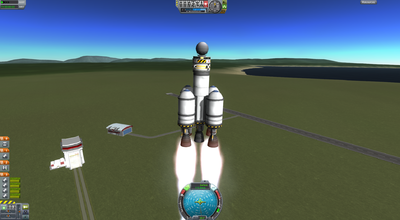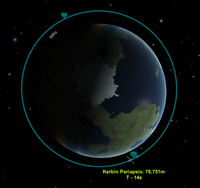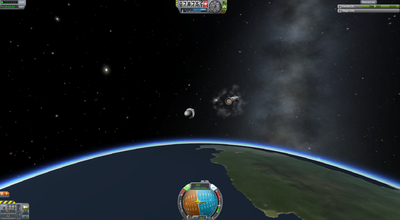Difference between revisions of "Tutorial: Sputnik 1/zh-cn"
(Index Chapter Zh-cn) |
m |
||
| Line 4: | Line 4: | ||
欢迎来到本教程的第一课,我们将在这里重现地球太空飞行历史上的一系列重要任务。在阅读本指南之前,你最好能先完成游戏自带的教程,以掌握基本的操作。 | 欢迎来到本教程的第一课,我们将在这里重现地球太空飞行历史上的一系列重要任务。在阅读本指南之前,你最好能先完成游戏自带的教程,以掌握基本的操作。 | ||
| − | + | 我们的第一个任务是“斯普特尼克”的发射,这是第一个进入环绕地球轨道的人造物体。1957 年,苏联成功的发射了“斯普特尼克”,并震惊了整个世界。当美国各军事机构的航天计划能给人留下印象的还是<strike>发射场的爆炸</strike>“非计划性航天器解体事件”,没有人能够料到苏联人已经在火箭科学中遥遥领先。“斯普特尼克”在太空中发出的“哔哔”声,全世界的业余电台都能接受到这一信号,对于西方航天界而言,它无疑是振聋发聩的巨响,他们从此意识到应该严肃面对太空飞行了。现在,我们就来在 KSP 中重现这一任务。 | |
我们要向太空发射一颗卫星,并让它进入稳定的轨道。就此而言,太空的定义是从 100 km 高度开始的,因为这里的大气层已经稀薄到不至于影响飞行器的地步,因此,飞行器可以于此长久的保持在轨状态。 | 我们要向太空发射一颗卫星,并让它进入稳定的轨道。就此而言,太空的定义是从 100 km 高度开始的,因为这里的大气层已经稀薄到不至于影响飞行器的地步,因此,飞行器可以于此长久的保持在轨状态。 | ||
Revision as of 08:03, 31 May 2013
| “ | 太空时代来临 —— 第一颗人造月亮正在绕地球飞行。 — Daily Express |
” |
欢迎来到本教程的第一课,我们将在这里重现地球太空飞行历史上的一系列重要任务。在阅读本指南之前,你最好能先完成游戏自带的教程,以掌握基本的操作。
我们的第一个任务是“斯普特尼克”的发射,这是第一个进入环绕地球轨道的人造物体。1957 年,苏联成功的发射了“斯普特尼克”,并震惊了整个世界。当美国各军事机构的航天计划能给人留下印象的还是发射场的爆炸“非计划性航天器解体事件”,没有人能够料到苏联人已经在火箭科学中遥遥领先。“斯普特尼克”在太空中发出的“哔哔”声,全世界的业余电台都能接受到这一信号,对于西方航天界而言,它无疑是振聋发聩的巨响,他们从此意识到应该严肃面对太空飞行了。现在,我们就来在 KSP 中重现这一任务。
我们要向太空发射一颗卫星,并让它进入稳定的轨道。就此而言,太空的定义是从 100 km 高度开始的,因为这里的大气层已经稀薄到不至于影响飞行器的地步,因此,飞行器可以于此长久的保持在轨状态。
Contents
Ship design
For this mission we will recreate the Soviet R7 rocket. It consisted of a first stage consisting of four engines around a second stage of one and the payload on top.
- Payload stage
- Second stage
- 1x TR-18A Stack Decoupler
- 1x FL-R25 RCS Fuel Tank
- 4x RV-105 RCS Thruster Block (symmetric radial-mounted)
- 1x FL-T800 Fuel Tank
- 1x LV-T30 Liquid Fuel Engine
- First stage
We are going to add a battery bank to the payload, because the Stayputnik command module requires energy to stay operational. During the ascend the engines will generate energy, but after we have it in orbit it will have to work on its own energy reserves. By itself it can store 5 units of energy which keeps it operational for just over 2 minutes. Afterwards it just becomes debris. The Z-500 adds another 500 units of energy which is enough to keep it operational for several orbits. Using the Z-100 battery packs would be more mass-effective, but unfortunately they aren't as elegant to integrate into a rocket design.
When you want your satellite to look more like the real Sputnik, you could also add four radially-mounted Communotron 16 antennas to the round part of the Stayputnik so that they face backwards in a 45° angle. But keep in mind that they don't do anything but making the mission more difficult by adding additional mass and drag to your rocket.
Note that the aerodynamic nose cones are technically just for show, because the current version of KSP (0.18.4) doesn't model atmospheric drag correctly. Any part you add to your rocket will make the drag worse, there is no way to reduce drag by adding more parts. Feel free to omit them when you don't care about aesthetics.
Mission phases
Lift-Off
Before you start your flight, switch on RCS and SAS so you have better control over your rocket. Also, switch your nav-ball from surface-mode to orbit-mode by clicking on the dial above it (it should read "Orbit 174.5m/s").
This phase is about getting out of the atmosphere as quickly as possible. The thick atmosphere around the ground creates drag which costs you fuel, so we will head straight up to get out of it. When you are ready, hold shift to set your throttle to maximum, and ignite your first stage by pressing space. Watch the nav-ball and keep your rocket pointed at the center for a perfectly vertical ascent. When the first stage burnt all its fuel, drop it and ignite the second stage using space (don't press space too often, or you drop your payload).
Gravity-Turn
When you've reached an altitude of 10km (should be shortly after igniting the 2nd stage), air resistance becomes much less. Now we start to build up vertical speed so we get fast enough to get into a stable orbit. Do this by tipping your rocket into the direction of the yellow direction marker on the nav-ball (90° eastwards). While your rocket faces the direction marker, the marker will slowly fall towards the horizon. This is good. Keep your rocket pointed at the direction marker, so it slowly tips towards the horizontal plane.
Getting into a circular orbit
While you perform your gravity turn, switch to the map view so you can see your flight path and you apoapsis. You can switch on the nav-ball in orbital view by pressing the comma-key on the num-pad. Do this so you don't get off-course. Your goal now is to get your apoapsis to about 100km. We need some additional height because we aren't out of the atmosphere yet, so we will keep losing some height due to atmospheric drag.
When you reached your apoapsis, perform a prograde boost - orient your rocket horizontal in eastern direction and burn your remaining fuel to get into a circular orbit. Should you run out of fuel, remember that you likely still have plenty of monopropellant left from the ascend. Press H to use it to accelerate forward. It doesn't do much, but it can be enough to give you the crucial last few m/s to get into a stable orbit.
Dropping the payload
After you are in orbit, drop your payload using space. Thanks to the powerful separator it will be blasted forward while the engine stage drifts behind. Congratulation, you just made space history. Go into time-warp and watch your satellite orbit Kerbin gracefully.
What next?
Unfortunately the satellite still has a limited lifetime due to energy use. To extend its life further it needs some kind of energy source in form of photovoltaic panels or a Radioisotope generator. When you have a sustainable energy supply, you can also add some scientific payload like accelerometer, barometer, thermometer or gravimeter. Note that all of this will increase weight and atmospheric drag, so you will need to add some more tanks to your rocket.
When unmanned satellites become boring, it's time to get to the next stage of space exploration: your first manned mission.





